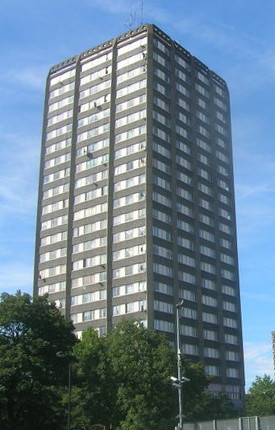
Grenfell Tower
Grenfell Tower is a derelict 24-storey residential tower block in North Kensington in London, England. The tower was completed in 1974 as part of the first phase of the Lancaster West Estate.[1] Most of the tower was destroyed in a severe fire on 14 June 2017.
This article is about the building. For the fire that destroyed it, see Grenfell Tower fire.Grenfell Tower
Lancaster Tower
Awaiting demolition
1972
1974
2016
2017 Grenfell Tower fire
£10 million
67.3 m (220 ft 10 in)
24
Clifford Wearden and Associates
A E Symes
Studio E Architects
- Rydon Construction
- Artelia
- Max Fordham
- WITT UK
- Harley Facades
- Celotex
- JS Wright & Sons
- Arconic
The building's top 20 storeys consisted of 120 flats, with six per floor – two flats with one bedroom each and four flats with two bedrooms each – with a total of 200 bedrooms. Its first four storeys were non-residential until its most recent refurbishment, from 2015 to 2016, when two of them were converted to residential use, bringing it up to 127 flats and 227 bedrooms; six of the new flats had four bedrooms each and one flat had three bedrooms. It also received new windows and new cladding with thermal insulation during this refurbishment.[2]
The fire gutted the building and killed 72 people, including a stillbirth.[3] In early 2018, it was announced that, following demolition of the tower, the site will be replaced by a memorial to those killed in the fire.[4]
As of December 2022, the Department for Levelling Up, Housing and Communities (DLUHC) has said that no firm plans exist for the tower, and that any decision will only be taken after community engagement.
Architect[edit]
Nigel Whitbread was the lead architect for the Grenfell Tower.[25] In an interview with Constantine Gras, quoted in The Guardian, he said that "he was born in Kenton, his parents had a grocer's shop on St Helen's Gardens, North Kensington. He was educated at Sloane Grammar school and then got a position with the architects Douglas Stephen and Partners, who, though small, were applying the principles of Le Corbusier and the modernists."[25] He worked alongside Kenneth Frampton who was the Technical Editor of the journal Architectural Design; and Elia Zenghelis and Bob Maxwell. He moved to work for Clifford Wearden after the basic plan for Lancaster West Estate had been established. He later worked for 30 years until his retirement at Aukett Associates.[26] Around 2016, he became involved with the local residents association drawing up the St Quintin and Woodlands Neighbourhood Plan.[27][28]
A residents' organisation, Grenfell Action Group (GAG), published a blog in which it highlighted major safety problems. In the four years preceding the fire, they published 10 warnings criticising fire safety and maintenance practices at Grenfell Tower.[29]
Prior to a fire, the Royal Borough of Kensington and Chelsea and central UK government bodies "knew, or ought to have known", that their management of the tower was breaching the rights to life, and to adequate housing, of the tower's residents, according to an enquiry by the UK Equality and Human Rights Commission (EHRC) published in 2019.[32]
In 2020, survivors of the fire stated that "nothing has changed" three years later and expressed feelings of being "left behind" and "disgusted" by a lack of progress in making similar buildings safe.[33]